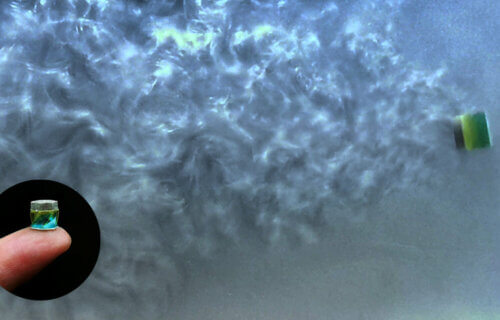
STANFORD, Calif. — A Transformer-style robot that can travel through the human body to cure diseases may be the future of medicine. A team of scientists from Stanford have created this tiny shape-shifting machine, inspired by the Japanese paper-folding art of origami.
The fingertip-sized robot is controlled by magnets and carries payloads of medicine directly to a tumor, blood clot, or infection. The “millirobot” is set to revolutionize medicine, replacing pills or intravenous injections that can cause life-threatening side-effects.
It can crawl, spin, and swim to enter narrow spaces, dispensing drugs or investigating the inner workings of the body. The actuator provides untethered control for non-invasive operations, allowing for miniaturization.
Corresponding author Dr. Ruike Zhao says the “spinning-enabled wireless amphibious origami millirobot” is as agile as its name implies. It moves “elegantly and speedily” over an organ’s slick, uneven surfaces and powers through body fluids — propelling itself wirelessly while transporting therapies.
Unlike pills or injected fluids, the robot withholds delivering medicine until “it reaches the target and then releases a high-concentration drug.” Dr. Zhao says the robot, described in Nature Communications, is “the most robust and multifunctional untethered robot we have ever developed.”
“That is how our robot achieves targeted drug delivery,” the mechanical engineer adds.
The groundbreaking design goes beyond most origami-based robots which only use foldability to control how they morph and move. Dr. Zhao likens certain actions to a minute accordion squeezing out medicine. The device’s dimensions also enable it to remain rigid on its way to missions. As a result, its unfolded form inherently lends itself to propulsion through the environment.
Such broad-minded considerations allowed the California team to get more out of the materials without adding bulk. The more functionality achieved from a single structure, the less invasive the procedure is, they explain.
Another unique aspect are geometrical features – including a long hole in the center and slits angled up the sides – to reduce water resistance and boost efficiency.
“This design induces a negative pressure in the robot for fast swimming and meanwhile provides suction for cargo pickup and transportation,” Zhao says in a university release. “We take full advantage of the geometric features of this small robot and explore that single structure for different applications and for different functions.”
The bot measures less than a third of an inch wide. It is fitted with magnetic plates and can change direction in an instant. Methods of locomotion are self-selected depending on the obstacles it has to overcome in the body, ranging from organs to torrents of fluid. Just by shifting the strength and orientation of the magnetic field, the robot can sail ten times its length in a single leap.
By folding or unfolding, a pumping action is able to deliver liquid medicine. Twisting also produces a sucking mechanism for transportation of cargo.
“We started looking at how all these work in parallel,” Zhao says. “This is a very unique point of this work, and it also has broad potential application in the biomedical field.”
Researchers hope the robots will eventually be carrying instruments or cameras into the body along with dispensing medicine. It would change how doctors examine patients. The lab team is also working on ultrasound imaging to track where robots go, eliminating any need to cut open organs.
Dr. Zhao’s “first-of-its kind” robot is currently undergoing tests prior to animal experiments. If they are successful, human clinical trials will follow. Study authors also plan to continue scaling down the robots to further biomedical research at the microscale.
South West News Service writer Mark Waghorn contributed to this report.

Regarding the title and the past 2 years:
I am sick and tired of “diseases created by scientists”